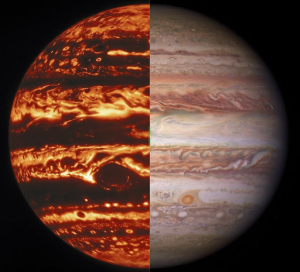24 Aug Jupiter’s new image
Gs paper 3
Prelims: about Jupiter, James Webb telescope
Mains: technological development in telescope and space study,
Why it is in news?
NASA has clicked new images of Jupiter, with the help of The JAMES Webb space telescope, the most powerful telescope till now.
Things to know about Jupiter

- Jupiter is the 5th planet in our solar system, it is, by far, the largest planet in the solar system – more than twice as big as all the other planets combined.
Jupiter, Saturn, Uranus, and Neptune are also known as Jovian or Gas Giant Planets. These are covered with a thick atmosphere, mostly consisting of helium and hydrogen. - Jupiter’s iconic Great Red Spot is a giant storm bigger than Earth that has raged for hundreds of years.
- Jupiter completes its single day in 10 hours called a Jovian day, however, takes about 12 Earth years to complete one orbit of the Sun called a Jovian year.
Jupiter has a maximum number of moons i.e natural satellite, more than 75 moons. - Jupiter’s four largest moons are called the Galilean satellites named after Italian astronomer Galileo Galilei, who first observed them in 1610.
These large moons, named Io, Europa, Ganymede, and Callisto, are each distinctive world. - the Voyager mission, in 1979, discovered Jupiter’s faint ring system.
the most recent spacecraft arrived at Jupiter in 2016, there are nine spacecraft that have visited Jupiter till now. 7 of them flew by and 2 of them orbited the gas giant. Juno,
The new image of Jupiter

- Till now the image of Jupiter has always been the same, a yellowish-orange giant sphere. But, the latest images of Jupiter captured by NASA’s newest James Webb telescope show the planet in a very different avatar.
- A greenish blue view of Jupiter can be seen in the latest infrared images of the planet reported by NASA.
- Earlier images of Jupiter’s stormy Great Red Spot, Ring, Aurora, and Aurora at the North and South Poles were not clearly visible in any photo taken to date.
- The famous Great Red Spot of Jupiter, a storm so big that it could swallow Earth, appeared bright white in the image since it was reflecting a lot of sunlight, the space agency stated.
- Apart from this, all the parts of this planet are visible in a single line in a wide field picture. Its dim rings, its two satellites i.e. the moons Amalthea and Adrastea, and the bright stars are visible in the Milky Way behind them. The format of the picture was infrared. The infrared images were artificially tinted blue, white, green, yellow, and orange.
What is the James Webb telescope.?
- The James Webb Space Telescope is a large infrared telescope. It is designed in a way that it can study every phase in the history of the universe. This includes the formation of the solar system, the Big Bang, and other theories that support life on other planets.
- It has the capability to look at the past such as the first galaxies formed in the early universe through its longer wavelengths. These wavelengths will help the telescope peer inside dust clouds from where the planets and stars are formed.
NASA developed the James Webb Telescope worth $10 billion with the assistance of the European Space Agency and the Canadian Space Agency. - The telescope was launched to space on December 25, 2021, in Ariane 5 ECA rocket from French Guiana in South America. and is currently observing from Lagrange point 2, approximately 1.5 million km beyond Earth’s orbit around the Sun. The telescope released its first image on July 11, 2022.
What are the main objectives of the James Webb Space Telescope? - It is to find the first galaxies formed after Big Bang.
- It is to calculate and determine how galaxies evolved from their earlier formation
- It is also to observe the formation of stars from the first stages
- And To measure the physical and chemical properties of planetary systems
National Aeronautics and Space Administration (NASA)
The National Aeronautics and Space Administration is America’s civil space program and the global leader in space exploration.
Established under the National Aeronautics and Space Act 1958
Headquarters: Washington, DC, USA
The main objectives of NASA
- To expand human knowledge of space
- To lead the world in space-related technological innovation
- To develop vehicles that can carry both equipment and living organisms into space
- To coordinate with international space agencies to achieve the greatest possible scientific advancements.




No Comments